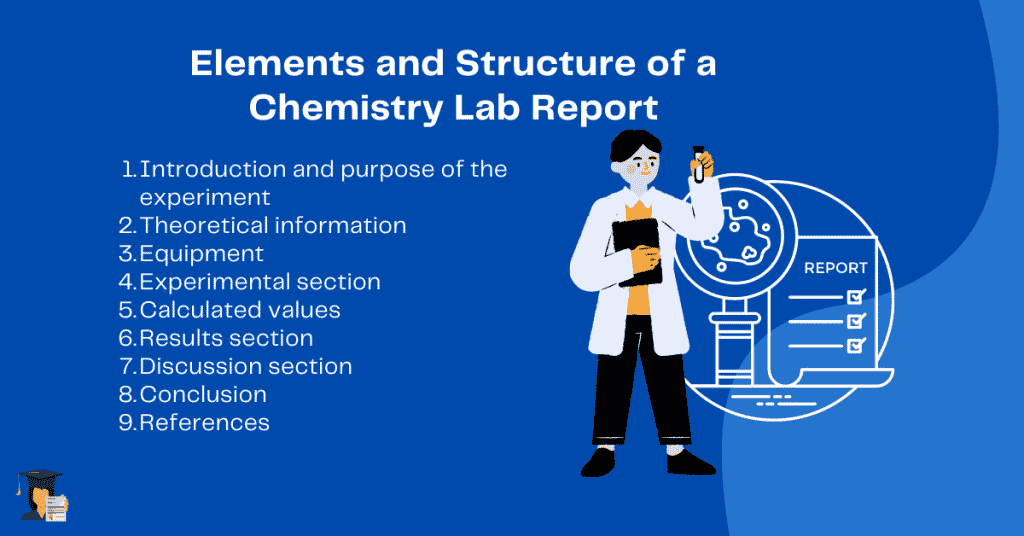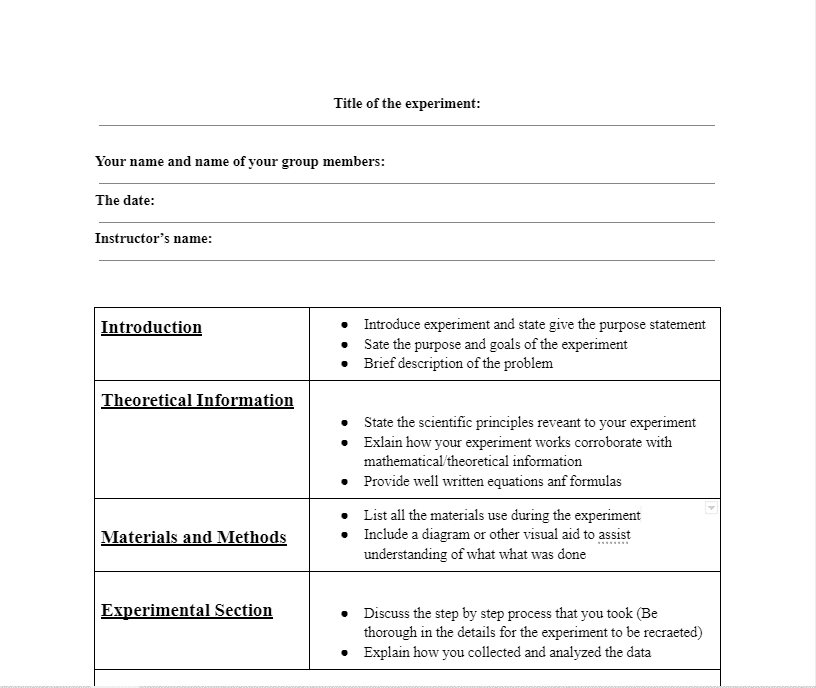A chemistry lab report is a document that describes a chemical experiment conducted in the laboratory. And as a student, Lab reports are the most critical part of all laboratory courses in college. And you’re probably asking yourself how to write a chemistry lab report. Stick around, and we will share with you just how to.
When given a lab report assignment, the first question is why a chemistry lab report is vital to students? Lab reports are essential because they allow students to reflect on their experimental procedures and think about how they could improve them. Equally important, it also allows students to write clear and concise lab reports, as these reports can significantly impact their grades in the course.
Thus, in this article, we will give you a step-by-step procedure on how exactly to go about writing a chemistry lab report. Let’s get started!
Elements and Structure of a Chemistry Lab Report.
There are different sections to note on how to write a chemistry lab report. Each lab report section has a specific purpose and needing clearly and concisely written. Let’s take a closer look at each section:

Title Page
The title page is your lab report’s first page, so it should include the necessary information. They include:
- The title of the experiment.
- Your name and the names of your group members.
- The date.
- Your instructor’s name.
The title should be brief and give an overview or description of the main point of the experiment. For example, “A”Study of the Effect of Acid on Steel.”
Introduction and Purpose Of the Experiment.
The first step is to introduce the experiment and the objective/purpose of your investigation. In this section, ensure you explain why you are conducting the experiment and what you should achieve/accomplish when doing your experiment. Moreover, include a brief description of the problem you are investigating and how your investigation will help to solve it.
Theoretical Information
A chemistry lab report uses the theoretical information section to describe the scientific principles relevant to your experiment. In the area, ensure that you provide the reader with enough mathematical/theoretical information for them to understand how the experiment works. You should also include any assumptions and their relation to the subject chemistry during the investigation. Provide the reader with well-written relevant equations and formulas. It will allow them to see the steps you took during the experiment. And remember, theoretical information does not have to be correct, but it should be testable.
Equipment( Materials and Methods)
In the equipment section, you will need to list the materials used in your experiment. This includes anything that you used to measure, record, or store data. For example, if you used a graduated cylinder to measure the volume of a liquid, you need to include that in your equipment list. Furthermore, when describing your methods, ensure you use explicit language. In addition, you should include a diagram or another visual aid that is often helpful to help readers understand what you did.
Experimental Section
The experimental section is the heart of the process of how to write a chemistry lab report. To write a thriving experimental area, you must first provide a step-by-step guide to the procedures you followed. Ensure to include enough relevant information for your instructor and another researcher could replicate your work. Also, have an explanation of how you collected and analyzed your data.
This section is written in the past tense, including enough detail for another researcher to replicate the work. If you follow these guidelines, you should be able to write a clear and compelling experimental section.
Calculated Values
When writing a chemistry lab report, you must include all the calculated values you obtained during your experiment. These values should be presentable in a table or graph depending on the most appropriate. Ensure you label all your tables and graphs and include a legend if necessary. Explain any calculations that you performed in your results section.
Results Section
The results section of a lab report presents the results you achieved and how you obtained the results, whether it is correct or not. The unit is divided into two for the understanding of the expected. These include:
- Text– In the text portion, you will need to discuss what these results mean to your hypothesis. Include information that will give your reader a clear understanding of what happened during your experiment. Be sure to include any relevant calculations.
- Figures– The figures should include all graphs and tables relevant to your results. Presenting your data in tables or graphs will make it easier for the reader to see trends and patterns. Be sure to label all tables and graphs clearly. Include a brief description of what each table or graph shows.
With all the results found, you should interpret them in the discussion section.
Discussion Section
In the discussion section, you will interpret your findings and discuss how they support or disprove your hypothesis. In this area, take time to evaluate and take the reader through the start of the experiment to the results stage. Examples of statements you can discuss:
- What was the purpose of the experiment?
- Did you achieve the expected results?
- Did you face any challenges during the investigation?
- Were there any implications that may have tampered with your results?
- Could you have done anything differently?
Considering all of this, you can help readers better understand your work’s significance by providing a detailed discussion of your results.
Conclusions On Your Work
To conclude a chemistry lab report, summarize the main points of the experiment and the results. Then, discuss any errors and appropriate corrections for future investigations. Finally, explain the significance of the results and how they contribute to our understanding of chemical principles. Following these steps ensures that your chemistry lab report is clear, concise, and informative.
References
If you used any sources in your research, include them in your references section. It will help readers understand where you obtained your information and how other researchers can use it in future research. In addition, by providing citations, you can help ensure that your work is properly credited.

Formating of a Chemistry Lab Report
How you format your chemistry lab report will depend on the class guidelines and the specific instructions from your instructor. However, some general rules must be considered when formatting a lab report. Here are some critical differences in the formatting of the reports that you should be aware of:
Font
Choosing a specific font style and size is essential for the format of your lab report. It is generally best to use a standard font such as Times New Roman or Arial. It makes your report easier to read and ensures the readers can easily find the information they are looking for.
Use consistent formatting throughout your report. For example, if you use italics for your section headings, be sure to use italics for all of your section headings. It will help your reader navigate your report more efficiently.
Indentation
Indentation is one of the most important aspects of formatting a chemistry lab report. Every report section should be indented, including your introduction, materials and methods, results, and discussion sections. Indentation helps to visually distinguish each section of your report, making it easier for your reader to follow.
All sections of your report should be double-spaced, with each new paragraph indented an additional half inch. The spacing makes your account easier to read and leaves room for any corrections or comments that your instructor may have.
Headings
Whatsmore, another essential aspect of formatting a chemistry lab report is the use of headings. Headings help to visually divide your writing into sections, making it easier for your reader to find the information they are looking for. It would be best if you generally used titles to divide your writing into sections such as introduction, materials and methods, results, and discussion.
Numbering Pages
Finally, it is essential to number the pages of your report. It will help your reader quickly find the information they are looking for and also helps to ensure that your account is appropriately organized. By numbering the pages of your report, you can help ensure that your work is properly credited.
Graphic Material
In addition to the above considerations, discussing the use of graphic material in your report is crucial. Graphic material can be beneficial in conveying your results and providing a visual representation of your work. However, using graphic material sparingly and only when needed is essential. In general, you should only use graphic material if it will help your reader to understand your results better or if it is necessary to provide a visual representation of your work.
How Long is a Chemistry Report?
The length of a chemistry report can vary depending on the class guidelines and the specific instructions from your instructor. A chemistry lab report should generally be around five to ten pages long. This length allows you to thoroughly discuss your results and provide a detailed discussion of your work.
Remember that you will need to specify how long each lab report section should be. The introduction, materials and methods, results, and discussion sections should be a few paragraphs long.
Tips on How to Write a Chemistry Lab Report.
Now that you are familiar with the general rules of formatting a lab report, it is time to discuss how to write an A+ lab report. One of the most challenging assignments in college science is learning how to write a chemistry lab report. Students must learn how to organize their thoughts, format their work, and present their findings clearly and concisely. Formality and scientific language are also essential.
The following tips will help you write an A+ lab report:
- Title all the sections of your lab report- Ensure you give headings to each section: the introduction, materials and methods, results, discussion, and conclusion.
- Use formal professional prose throughout your report- Your sentences should be clear and unambiguous with no information.
- Never use “I” “r “M”-“Do not use first-person pronouns in the body of your report and the abstract.
- Be clear and concise- Clear communication promotes more structured thinking and understanding of your writing.
- Do not use quotes- It is not appropriate to use quotations in technical experimental documents.
- Be sure to proofread your work carefully- Doing this will help ensure that your work is error-free and meets your instructor’s expectations.
Conclusion
In conclusion, when learning how to write a chemistry lab report, it is essential to remember the specific audience you are writing for. Your instructor will read your account and look for a well-written, well-organized document. Naturally, be sure to proofread your report carefully before submitting it. Thus, by following the guidelines we have shared, it’s time to put your skills into practice.
Are you working on a research paper for school? Want to impress your professor with a unique lab report? Bright Writers can help. We offer professional writing services that will take your content to the next level. Contact us today and let us show you what we can do.

What is a lab report?
A lab report is a document that describes the process, results, and discussion of a laboratory experiment.
What’s the difference between a lab report and a research paper?
A lab report is written to describe and analyze a laboratory experiment that explores a scientific concept. A research paper is an in-depth study of a particular topic.
What are the sections of a lab report?
The sections of a lab report include:
The Introduction.
Materials and Methods.
Results section
Discussion section.
What’s the difference between results and discussion?
The results section of a lab report is where the data from the experiment is presented. The discussion section is where the interpretation of the data is discussed.



